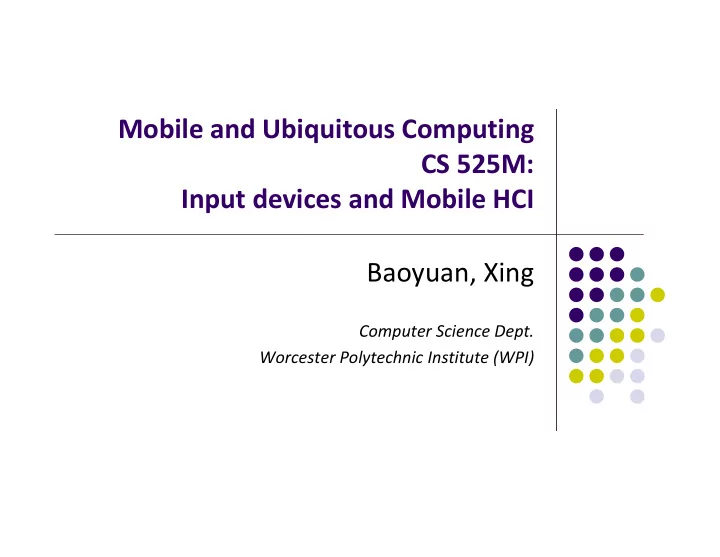

Mobile and Ubiquitous Computing CS 525M: Input devices and Mobile HCI Baoyuan, Xing Computer Science Dept. Worcester Polytechnic Institute (WPI)
Human Phone Interaction : EyePhone http://www.youtube.com/watch?v=lyBZgfAdNlg Human Phone Interaction (HPI) represents an extension of the field of Human Computer Interaction (HCI) Challenging issues in HPI : Mobility Resource limitations EyePhone: Interact with the phone via eye Advantages : No degrade from noise Kind of interesting Easy to use by disabilities
Related work Lots of developments in HPI using eye interaction over the last several years [5,23,11,13] The eyeSight technology, simple hand gestures over the camera used to control the phone [5]. The OpenEye relies on an eyeglasses mounted camera to track a person’s eyes to realize HCI applications[23]. Fixed cameras in desktop machine picks up eye movement and uses the eye as a mouse in [11], or to enable general HCI applications [13]. However, these systems are for static machines, using a specific fixed infrastructure of external sensors and cannot be easily replicated on mobile phones
Designs in EyePhone Pre ‐ processing for image to locate eyes contour Challenge : unavoidable movement in HPI Solution : reduce the resolution of image filter the false eye contour using threshold Eye Template Created by users individually, stored in memory (distance of about 20 cm from the eyes) Save time & Save energy (Compared with using online eye template)
Designs in EyePhone Eye Tracking Calculates a normalized correlation score (range : [ ‐ 1,1]) Greater than 0.4 is viewed as true positive Search window is limited to a region(twice open eye size) Reduce computation time Blink Detection Two issues compared with HCI : Quality of the camera is not the same as a good USB camera Camera is closer, causing iris movements detected (i.e. eyeball rotation) Fixed four thresholds are used to detect blink based on experiments
Evaluation of EyePhone Phone : Nokia N810 , OS: Maemo 4.1, a Unix based platform Eye tracking and blink detection
Evaluation of EyePhone Accuracy of eye tracking and blink detection in different situations (All experiments are repeated five times and average results are shown) DS : Daylight exposure & stationary AS: Artificial light exposure & stationary DM: Daylight exposure & walking; BD : Blink detection accuracy in daylight System Measurements
Evaluation of EyePhone Impact of Distance Between Eye and Phone Accuracy degrades if distance more than18-20 cm, as expected
Conclusion Design and implement a HPI called EyePhone using front camera. EyePhone relies on eye tracking and blink detection, to allow users activate the apps on the phone by eye blink Although preliminary (yes, it is quite preliminary), results indicate that EyePhone is a promising approach to driving mobile applications in a hand ‐ free manner.
Future work and some apps Two issues : Creation of the open eye template One ‐ time template might not match the eye in other environments i.e. Template created in daylight does not match the eye in darker setting Filtering algorithm for wrong eye contours Fixed threshold policy is not perfect. Adaptive filter with machine Learning is better Simple Applications : EyeMenu: Launch apps using eye blink, used by disabilities. Car Driver Safety: Detecting drowsiness and distraction
Discussion Questions: How to know if the eye blink is to interact with phone or just for blinking In the video, the phone is exactly in front of the face. What is the tolerance of phone with some angle towards the eye. Thank you !!!
References [5] eyeSight. http://www.eyesight ‐ tech.com/. [11] The Eye Mouse project. http://www.arts.ac.uk/research/eyemouse/index.htm. [13] M. Chau and M. Betke. Real Time Eye Tracking and Blink Detection with USB Cameras. In Boston University Computer Science Technical Report No. 2005 ‐ 12, 2005. [23] D. Li, J. Babcock, and D.J. Parkhurst. openEyes: a Low ‐ Cost Head ‐ Mounted Eye ‐ Tracking Solution. In2006 Symposium on Eye Tracking Research & Applications, page 100. ACM, 2006.
Recommend
More recommend